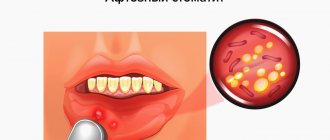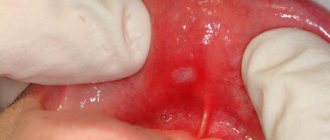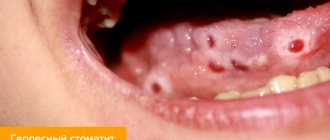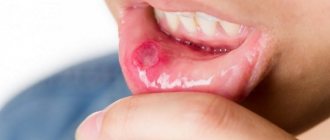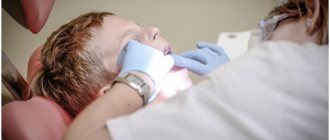Causes of aphthous stomatitis
The exact cause of this disease remains unclear. It is assumed that HRAS is of an allergic nature; allergens can include: food, medicine, toothpastes, dust, worms.6,7 It is also assumed that the cause of the disease is an autoimmune reaction.8 A hereditary predisposition to this disease can be traced.
Predisposing factors:
- diseases of the digestive system (gastritis, gastric ulcer, cholecystitis, Crohn's disease)
- dysbacteriosis
- stress
- deficiency of iron, vitamins B1, B2, B6, B12, C
- chronic tonsillitis, otitis and rhinitis
Causes
To date, the exact etiology of aphthous stomatitis has not been fully identified. The main cause is considered to be a disruption of the immune system (uncontrolled activation of lymphocytes and neutrophils, which begin to destroy epithelial cells). At some point, the immune system ceases to recognize a number of components contained in saliva, which provokes the appearance of characteristic ulcers. However, this is far from the only reason. The aphthous form of stomatitis occurs under the influence of other factors:
- genetic predisposition
- immune system diseases
- gastrointestinal diseases
- neutropenia, Behcet's syndrome
- allergies to sodium lauryl sulfate, citrus fruits, dairy products, grains
- viruses and pathogenic bacteria (staphylococci)
- mucosal injuries
- avitaminosis
- pregnancy
- psychological disorders
HRAS classification:
| CAUSES | A COMMENT | ||
| causes: | Clinically, several forms of HRAS are distinguished: | a comment: | 1) fibrinous form: the size of aphthae is 2-3 mm, heal in 6-8 days 2) small canker sores (Mikulich’s aphthae): the size of aphthae is up to 1 cm, heal in 10-14 days 3) large Setton’s aphthae: the size of aphthae is from 1 to 3 cm, heal for a very long time, up to several months, leaving scars 4) herpetiform type: the smallest aphthae that merge |
| causes: | HRAS as a symptom of the disease: | a comment: | 1) Behcet's disease 2) Reiter's disease |
| causes: | According to severity, HRAS is divided into: | a comment: | 1) mild form: 1-2 aphthae, once every 2 years 2) moderate form: 3-6 aphthae, relapse 2 times a year 3) severe form: more than 6 aphthae, relapse several times a year |
Types of disease
According to ICD-10, aphthous stomatitis is assigned code K.12. Within the code there are three qualifying diagnoses, including K.12.0 - “recurrent aphthae of the oral cavity,” which also includes aphthous ulcers.
According to the form of occurrence, acute and chronic aphthous stomatitis are distinguished. The first is characterized by the appearance of ulcers and severe hyperemia - swelling, redness of the mucous membranes. Severe pain occurs, especially when eating or talking. Submandibular lymph nodes may enlarge and body temperature may rise.
Chronic recurrent aphthous stomatitis may be the result of improper or untimely treatment, as well as the inability of the immune system to cope with the disease. It is characterized by periodic exacerbations. Outside of exacerbation, symptoms may be erased or completely absent.
The disease is classified into three forms depending on the severity:
- light. From 1 to 2 afts up to 10 mm in size. Moderate pain during mechanical action, relapses occur no more than 2 times a year;
- average. Up to 5 aft, the course of treatment takes up to 3 weeks. The pain is quite pronounced, there is an enlargement of the lymph nodes, relapses up to 2 times a year;
- heavy. Multiple aphthae appear, severe pain. An increase in temperature occurs, and symptoms of general intoxication appear. Treatment takes up to a month, relapses occur up to 6 times a year.
Also, according to the form of occurrence, the following types of inflammatory diseases are distinguished:
- fibrous: blood microcirculation in the upper layer of the mucosa is disrupted, aphthae appear, covered with a fibrous film (plaque). Such ulcers heal completely within 14 days. The disease affects the mucous membrane of the lips, the lateral surfaces of the tongue, and transitional folds. This stomatitis recurs up to 3 times a year;
- necrotic. The epithelium is destroyed, the mucosal area dies. Replacement of tissues with normal epithelium takes from 14 to 30 days. This aphthous stomatitis is not accompanied by acute pain; it is usually observed in patients with severe diseases, including blood pathologies;
- grandular. Damage to the ducts of the minor salivary glands occurs. In this regard, aphthae form close to the glands, and drying of the mucous membranes of the oral cavity occurs due to a decrease in saliva production. Ulcerations are painful and heal within 1–3 weeks;
- scarring. Damage to the cavity of the salivary glands leads to the involvement of connective tissue in inflammation. Aphthae are observed both at the location of the glands and on the mucous membranes of the pharynx and palate. The disease develops into large painful ulcers (up to 1.5 cm). Healing takes up to 12 weeks; after the acute process, pronounced scars remain;
- deforming. The most severe form of the disease, which provokes changes in connective tissue. Aphthae heal extremely slowly, which is accompanied by deformation of the palate, lips, and sometimes narrowing of the oral cavity occurs (if aphthae was observed in the corners of the mouth).
Ask a Question
HRAS as a symptom of the disease
Behçet's disease is a disease of unknown etiology, characterized by vascular damage, the appearance of aphthae in the oral cavity and genitals, damage to the eyes, joints, gastrointestinal tract, central nervous system and other organs. It has a chronic course and, if left untreated, can lead to disability.9
Symptoms:
HRAS
HRAS is the earliest symptom of the disease; aphthae can be of any size, recur at least 3 times a year, and are often located on the mucous membrane of the cheeks, lips, gums, tongue
Eye damage
Uveitis (inflammation of the membrane of the eye), blurred vision, “fog” before the eyes, redness of the eyes (rarely), lacrimation
Genital ulcers
Similar to mouth ulcers, but deeper and more painful
Skin redness
The skin exhibits erythema nodosum (red, painful subcutaneous nodules), rash
Other
- vessels in the form of thrombosis, aneurysms
- Nervous system damage: coma, meningitis, confusion
- joints may also be affected in the form of arthritis
Reiter's disease is a systemic infectious disease characterized by damage to the oral mucosa, genitourinary system, eyes and joints.10 The triggering factor for infection is often chlamydia and gonococci, and there is also a genetic predisposition. The disease has a severe course, and in case of complications it leads to disability (blindness, deforming arthritis) and even death.
It is important to remember that HRAS may indicate the presence of a serious systemic disease.
Types of stomatitis
In medicine, it is customary to distinguish two types of stomatitis:
- acute gingivostomatitis, which is caused by various viral infections;
- recurrent stomatitis (caused by staphylococci, immune diseases and problems with the gastrointestinal tract). As the name suggests, the disease tends to occur again and again - periods of exacerbation occur in autumn and spring, when there is a lack of vitamins.
Separately, it is worth highlighting herpetic stomatitis, which affects not only the immune system, but also the nervous system. It occurs most often in children under 3 years of age: during this period, firstly, the influence of maternal immunity on the baby’s body rapidly weakens, and secondly, the child begins to go to kindergarten, where he interacts with other children who may already be infected with the virus herpes.
Prevention of HRAS
Prevention should be aimed at monitoring the state of health in general, treating chronic diseases, and it is necessary to undergo regular examinations regarding the existing disease. Hardening and strengthening the immune system have a good effect. You need to visit the dentist to monitor your oral health once every 3-4 months to ensure timely detection of relapses. You should avoid using toothpastes, hygiene products with dyes or identified allergens. Taking antibiotics should only be done under the supervision of a doctor. It is recommended to avoid strong psycho-emotional stress and regularly carry out wet cleaning of the premises.
It is worth paying attention to Tantum® Propolis .
Tantum® Propolis
Propolis has an immunostimulating effect, promotes healing, vitamin C, which is part of it, is responsible for regeneration, participating in the synthesis of collagen.
Propolis also has antiviral and antifungal effects. Therefore, vitamin therapy Tantum® Propolis is an effective means of preventing stomatitis12 Find out more
Possible reasons
The development of aphthous stomatitis occurs with a decrease in immunity, but not all children suffer from it. The activity of pathogenic microorganisms can occur in a child against the background of constant stress, climate change and hereditary predisposition.
Aphthous stomatitis in children is also provoked by diseases such as:
- avitaminosis;
- stomach ulcer;
- viral hepatitis;
- allergy;
- herpes virus;
- acute respiratory diseases;
- tuberculosis;
- blood diseases;
- advanced caries.
- Infection with a pathogen can occur in the following ways:
- when eating vegetables or fruits that have not been washed beforehand;
- in case of involuntary damage to the oral mucosa;
- with mechanical trauma (wounds) of the oral mucosa;
- for burns of the mucous membrane by hot food or drink;
- through dirty objects or hands.
In most cases, with “strong” immunity, infection can occur, but the infection remains in “dormant mode”, or the body’s immune system destroys it. If the influence is exerted by a provoking factor, the pathogen begins to multiply, affecting a large area of the oral cavity.
Forms of the disease
Aphthous stomatitis can occur in two forms: chronic and acute. Each form of pathology has its own characteristics of symptoms, which help establish the clinical picture during diagnosis.
Acute form of aphthous stomatitis
The pathological condition is accompanied by puffiness and swelling of the mucous membrane, on which aphthae of gray or white color and round shape are formed. With timely initiation of treatment, acute stomatitis lasts up to 10 days. After therapy, the mucous membrane is completely restored.
Chronic form of aphthous stomatitis
It develops in the absence of treatment for acute stomatitis, hereditary predisposition or the presence of chronic diseases that affect the immune system. The peculiarity of the pathology is the occurrence of periodic relapses. The duration of the disease is up to 14–30 days.
What symptoms accompany the pathology?
In children, aphthous stomatitis develops gradually. At the initial stage, when the infection spreads through the mucous membrane, the child may not have any signs of damage.
The main symptom of aphthous stomatitis is the formation of erosions on the oral mucosa, which are called aphthae. They are formed as a result of damage to the mucosa. At the site of injury, aphthae are formed, having the shape of a circle or oval. After 6–14 hours, aphthae transform into erosions with a fibrous white-gray coating.
The disease may be aggravated by other symptoms:
- severe weakness;
- fast fatiguability;
- refusal to eat;
- temperature rise above 38°C;
- swelling of the mucous membrane;
- change in taste sensations;
- redness of the mucous membrane;
- enlarged lymph nodes in the neck.
Childhood aphthous stomatitis progresses much faster. After the first aphthae appear, within 24 hours a large number of erosions can form throughout the entire oral cavity. And on days 2–3, the child’s general well-being worsens.
Classification by clinical manifestation
Depending on the manifestation and characteristics of the development of aphthae, the disease is classified into several forms.
- Fibrinous. Aphthae are formed after fibrous damage to the mucosa.
- Necrotic. Accompanied by the death of the affected mucosal cells.
- Glandular. It affects not only the mucous membrane, but also the salivary glands.
- Scarring. Aphthae are up to 1 cm in size. Treatment can last up to 3 months. After healing, scars remain on the mucous membrane.
- Deforming. Multiple formations. After the erosions are eliminated, the structure of the mucous membrane changes, and scars appear in place of the aphthae.
- Lichenoid. Mostly occurs on the tongue. The disease is characterized by the presence of a white cushion around the aphthae.
Since aphthous stomatitis in children can manifest itself in different forms and degrees of severity, treatment is always determined individually. The main goal of the doctor is not only to eliminate not only the symptoms, but also all the risks of a possible relapse.
Features of formations
The infection affects not only the mucous membrane, but also soft tissues, as well as blood vessels that enlarge and dilate. The result is edema and hypothermia.
Aphthae have characteristic signs:
- clear edges;
- round or oval shape;
- size 3–5 mm;
- yellow, white or gray;
- red edges;
- plurality;
- large distribution area;
- elevation above the surface;
- severe pain.
Aphthous stomatitis occurs in three stages.
- Premonitory. The initial stage, in which the mucous membrane is inflamed, but dry. The child may feel discomfort and pain. The temperature rises. The general condition is deteriorating.
- Rashes. The second stage, at which the child already has rashes. To the deterioration of the general condition, refusal to eat due to pain when eating is added.
- Fading. The disease resolves on its own after 10–14 days, but becomes chronic.
With therapy, complete recovery occurs no earlier than after 7 days. The symptoms are gradually eliminated, and the mucous membrane is covered with a new healthy layer.
Drugs for the treatment of stomatitis
How to treat stomatitis in adults and children?
In the pharmacy you can find a huge number of drugs that help in the fight against stomatitis, the cause of its occurrence and symptoms.
Most of them are sold without a prescription, so anyone can purchase the drug. In the treatment of stomatitis, an integrated approach is used: it is necessary to influence the cause of the disease, as well as alleviate the severity of symptoms.
Painkillers
If the ulcers interfere with eating and talking, or cause great discomfort for the patient, it is considered advisable to prescribe painkillers for topical use. These include:
- Anestezin is available in tablet form for grinding into powder. It has a local analgesic effect on the mucous membrane in the affected area.
- Hexoral is an effective tablet for resorption in the mouth, helping in the fight against ulcerative lesions of the mucous membrane. They have a double result - the drug has an antibacterial and anesthetic effect.
- Lidocaine Asept is available in the form of a spray, which is convenient for topical use. The drug contains lidocaine and chlorhexidine: they provide a disinfecting and analgesic effect. This spray is preferable for ulcerative stomatitis.
- Lidochlor - this gel relieves pain and has an antibacterial effect on the oral mucosa, relieves inflammation.
Herbal remedies - a decoction of chamomile, calendula, sage, also have some antiseptic properties and have a calming effect on the mucous membrane. They help relieve inflammation and relieve swelling of the affected mucosa.
Antiseptics and anti-inflammatory drugs
These drugs are the basis for the treatment of stomatitis. They are produced in the form of tablets for resorption in the oral cavity, in the form of sprays for irrigation of the mucous membranes, ointments, gels, etc.
- Kamistad - contains chamomile, which provides relief from inflammation and a calming effect. Lidocaine has an analgesic effect on the affected mucous membrane.
- Cholisal is available in gel form. Has an excellent anti-inflammatory and antibacterial effect.
- Stomatidine (hexetidine) is an antiseptic drug widely used in dental practice.
- Cametone – contains essential oils, has an antimicrobial and local anesthetic effect. Sold in pharmacy chains in the form of an aerosol or spray.
Ingalipt and Hexoral sprays are also used for topical use for stomatitis. They prevent the spread of infection in the oral cavity and speed up the onset of recovery.
Special products for the treatment of stomatitis in adults
Depending on the cause of the development of stomatitis - a fungus, a virus or a bacterium, specific medications are selected.
Acyclovir, Zovirax are used to combat herpetic stomatitis; in some cases, it is advisable to use interferons. When treating fungal stomatitis, the doctor may prescribe Mycozon, Levorin, nystatin ointment, etc. Bacterial stomatitis requires the prescription of antibiotics, taking into account the sensitivity of microorganisms.
Drugs that enhance regeneration
In this case, drugs that accelerate the healing process of damaged mucous membranes can help.
- Solcoseryl - this medicine is often used in the practice of a dentist. Available in the form of a paste, which must be applied to the lesions. Solcoseryl helps improve trophic processes and accelerates tissue regeneration;
- Sea buckthorn oil is an excellent natural remedy; it helps accelerate the healing of mouth ulcers;
- Vinylin is an antiseptic balm. The principle of action is to envelop the ulcers and heal them more quickly;
- Proposol spray - the effect of the drug is based on propolis.
In the case of an allergic form of pathology, the first step in treatment is the identification and exclusion of the allergen. Some people may experience an allergic reaction after getting braces or dentures, or when using a new drug. Since ulcers in this form of stomatitis are a symptom of the body’s reaction to an allergen, it is the allergy that must be eliminated first. Antihistamines are used for this purpose. You can take them in the form of tablets or applications to the mucous membrane.
There are contraindications. Specialist consultation is required.
Dentists' recommendations
Prevention of aphthous stomatitis is the surest way to prevent the disease in children. Parents of children with a hereditary predisposition, chronic diseases or weakened immunity should pay the greatest attention to preventive measures.
To reduce the risk of developing aphthous stomatitis, dentists recommend:
- monitoring the child's nutrition;
- exclusion of allergenic products (if indicated);
- periodic intake of vitamin complexes;
- maintaining oral hygiene at home;
- professional teeth cleaning every 6 months;
- timely treatment of dental diseases;
- treatment of any provoking diseases;
- contact your dentist at the first symptoms of aphthae.
Aphthous stomatitis is a complex dental disease caused by infection. Treatment of infectious pathology at home often only helps to eliminate symptoms and transition of the disease to a chronic form. Contacting a qualified dentist will allow you to individually select treatment tactics for complete recovery or achieve long-term remission with subsequent “attenuation” of the infection.
Diagnostics
Aphthous stomatitis is a dental disease, so the right decision would be to seek help from a dentist. For quality treatment, diagnostics are required.
The main method of collecting anamnesis is interviewing the child and parents about complaints, as well as examining the oral cavity. Considering how many features the disease can have, only a qualified and experienced specialist should treat a small patient.
After determining the clinical picture, possible causes and the presence of provoking factors, the doctor can draw up a treatment regimen.

